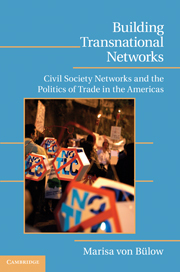Book contents
- Frontmatter
- Contents
- List of Figures
- List of Tables
- Acknowledgments
- Part One Civil Society Organizations and Their Pathways to Transnationality
- Part Two The Politicization of Trade
- Part Three The Dynamics of Networks
- 5 TRADE PROTEST NETWORKS
- 6 THE ORIGINS AND DYNAMICS OF TRADE CHALLENGERS' NETWORKS
- Part Four Organizational Pathways to Transnationality
- Part Five The Search for Ideational Pathways
- Main Abbreviations Used
- Appendix A Lists of Interviews
- Appendix B Social Network Questionnaire (United States)
- Bibliography
- Index
5 - TRADE PROTEST NETWORKS
Published online by Cambridge University Press: 05 October 2010
- Frontmatter
- Contents
- List of Figures
- List of Tables
- Acknowledgments
- Part One Civil Society Organizations and Their Pathways to Transnationality
- Part Two The Politicization of Trade
- Part Three The Dynamics of Networks
- 5 TRADE PROTEST NETWORKS
- 6 THE ORIGINS AND DYNAMICS OF TRADE CHALLENGERS' NETWORKS
- Part Four Organizational Pathways to Transnationality
- Part Five The Search for Ideational Pathways
- Main Abbreviations Used
- Appendix A Lists of Interviews
- Appendix B Social Network Questionnaire (United States)
- Bibliography
- Index
Summary
This chapter lays out the networks created among challengers of trade agreements in the Americas in the last twenty years of mobilizations and debates. Based on a combination of data gathered through social network questions answered by informants, document analysis, and semistructured interviews, it presents an analysis of how actors relate to each other, within and across national borders. The embeddedness of actors in these networks tells us much about their strategies and goals, and helps us understand changes in their pathways to transnationality.
Informants from one hundred and twenty-three civil society organizations (CSOs) in Brazil (29), Chile (23), Mexico (30), and the United States (41) answered the same questionnaire (see the lists of organizations in Appendix A and a copy of the questionnaire in Appendix B). This was not meant to be a representative sample of the literally hundreds of CSOs that became involved in challenging free trade agreements at one point or another. However, they do include the major challengers in each country, until the freezing of the Free Trade Area of the Americas negotiations in about 2004.
The mapping of ties among trade agreement challengers focused primarily on the strongest relationships among them, based on the perceptions of intensity of relations among informants at the time of the interview. Thus, the social networks presented in this chapter do not represent all forms of interaction among actors.
- Type
- Chapter
- Information
- Building Transnational NetworksCivil Society and the Politics of Trade in the Americas, pp. 67 - 80Publisher: Cambridge University PressPrint publication year: 2010

